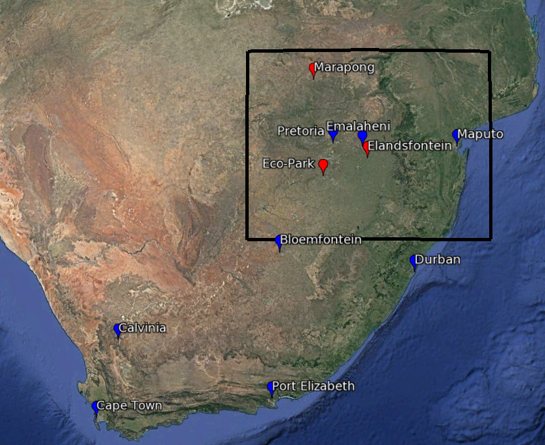Modelling of Atmospheric Mercury in South Africa
Financed by: University of Pretoria, Laboratory for Atmospheric Studies (LAS)
Period: July 2016 – October 2016

Introduction
Ambient atmospheric Hg standards are imminent. However, little is known about atmospheric Hg in the interior of South Africa, since reliable and long-term observations are extremely limited. Most South African Hg work published to date has therefore been derived from the Cape Point Global Atmospheric Watch (GAW) station. In order for industry to meaningfully participate in future discussions related to ambient Hg standards, pre-emptive research on Hg concentrations across the South African interior, and especially over the Highveld and Vaal-Triangle Air Quality (industrial interior) priority areas. Such research should involve the modelling of atmospheric Hg emissions (natural and anthropogenic), its dispersion through the atmosphere, its chemical transformation, its deposition and its interaction with the climate system. Such modelling, if verified against observations, could provide valuable information regarding the interactive spatial extent of Hg over the South African interior.Description
The research involved the following activities:- WRF model simulations (2009 – 2014) to generate fine resolution meteorological variables (e.g. winds and temperatures) as input to Cal-Met (Cal-Puff) and Sci-Chem (Sci-Puff) chemistry dispersion modeling will be completed. This is an extension of the research conducted in 2014;
- Implementation of Sci-Chem/Puff (off-line with Hg code added) in order to establish Sasol and Eskom’s Hg contribution to the Highveld and Vaal Triangle priority areas (industrial interior);
- Implementation of Cal-Puff (off-line with Hg code added) in order to establish Sasol and Eskom’s Hg contribution to the Highveld and Vaal Triangle priority areas (industrial interior);
- Verification of Sci-Chem/Puff and Cal-Puff simulations against observations;
- Implementation of the interactive WRF/WRF-Chem (on-line with Hg code added) system in order to generate the net-budget of Hg (natural and anthropogenic) for South Africa – initial simulations might be completed;
- Derive a simple Multi-Linear Regression (MLR) equation(s) that could be used to simulate ground level Hg, if the afore-mentioned models do not succeed;
Objectives
- model dynamic processes of mercury on local, regional and global scales; specific attention will be devoted to the assessment of the interaction between the atmospheric and terrestrial and aquatic ecosystems in South Africa
- improve mercury emission inventories through better characterization of anthropogenic (combustion and non-combustion) and natural sources, including chemical speciation
- identify technologies to reduce emissions or remove mercury from waste streams develop communication tools for mercury to promote pollution prevention and risk management solutions
Partnership
- University of Pretoria (UOP)
- CNR-IIA

Ian M. Hedgecock
Scientific Coordinator
email: i.hedgecock@@@iia.cnr.it
Gruppo di lavoro
Christian N. Gencarelli
email: c.gencarelli@@@iia.cnr.it
Francesco De Simone
email: f.desimone@@@iia.cnr.it
